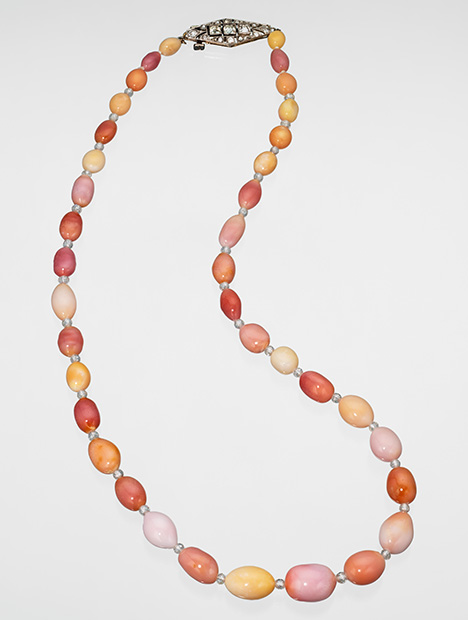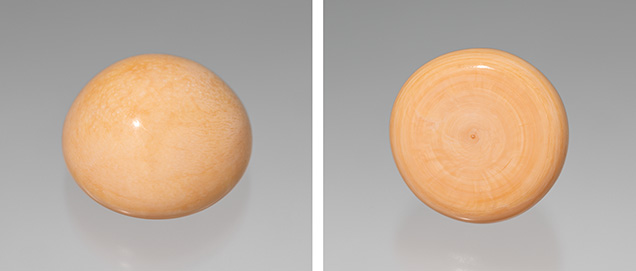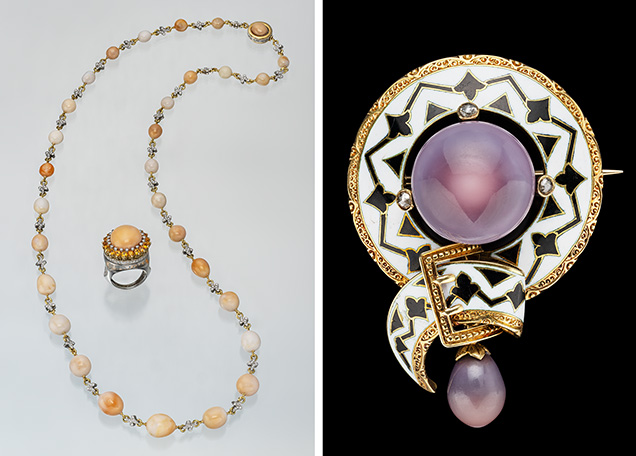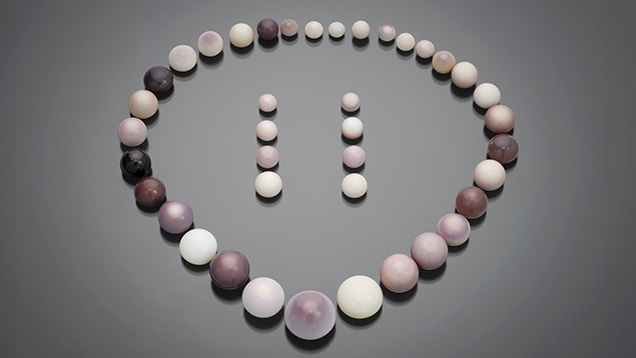The Appeal of Non-Nacreous Pearls

Pearls never disappoint at the AGTA and GJX shows, and this year was no exception. While quantities were lower, a good supply of Tahitian, freshwater, and South Sea pearls was available. AGTA hosted a booth sponsored by Martin Rappaport featuring nacreous natural pearls from Bahrain, complete with reports from DANAT, the Bahrain Institute for Pearls & Gemstones. Of particular interest was a wide selection of natural non-nacreous pearls.
Several vendors at GJX offered non-nacreous conch pearls, with a smaller selection available at the AGTA show. Alec Rupp-Smith of Aloha Pearls Hawaii showed a fabulous graduated, mixed-color conch pearl necklace (figure 1) at both the GJX and Pueblo shows. The necklace featured 37 conch pearls with a total weight of 179 carats. Thirty-two diamonds, 9.06 carats total, were used as accents to the suite of pearls.

Rupp-Smith also presented an interesting Melo pearl from Myanmar (figure 2). The pearl was clearly cut in half, with the other half likely fabricated into jewelry. The remaining 57 ct half was polished to display the fine concentric rings used to help separate bead-nucleated cultured pearls from their natural counterparts, without the need for X-ray tomography. The banding was visible even without a loupe.
Somewhere in the Rainbow returned to the AGTA show to highlight recent acquisitions to their ever-growing collection. The mission of the collection is to bring education and enjoyment of fine colored gems to museums, galleries, and facilities dedicated to preserving the rarity and beauty of these minerals, gems, and articles of jewelry. The collection features pearls and colored stones from a wide contingent of designers from around the world. This year, three non-nacreous pearl creations stood out, sourced from Carlos Chanu, owner of California-based PCD Pearls.

The first was a Cassis pearl suite consisting of a graduated necklace and convertible ring/brooch all fabricated in 18K gold and platinum by designer Jim Grahl of Balboa Island, California (figure 3, left). Chanu sourced the pearls from Europe over the course of one year. The layout of the necklace took a month to get just right, with a nicely matched blend of size, shape, and color. The ring/brooch pearl is one of the finest examples of Cassis known.
The second is the “Golash” brooch in figure 3 (right), named after the man who purchased it at an antique store in 2000 for $14, dates back to 1835 and was fabricated in the state of Rhode Island. Two rare quahog pearls (Mercenaria mercenaria) are set in the piece. At 13.5 ct and 13 mm, the larger, slightly button-shaped pearl has a glass-like surface and stunning color that make it an exceptional natural quahog pearl. Mercenaria pearls are rare, found as a byproduct of the clam fishing industry on the East Coast of the United States. The smaller, near-perfect drop-shape pearl measures nearly 9 × 7 mm and weighs 2.89 ct. Uniform natural drop pearls are among the rarest for any mollusk. As part of an international pearls exhibition, the “Golash” brooch toured the world from 2001 to 2008.

Pacific Coast Pearls (Henderson, Nevada) brought an impressive array of natural pearls to GJX this year. After owner Wes Rankin found his first abalone pearl while diving off the coast of California, he spent the next decade collecting and purchasing pearls. This led to what has become one of the largest selections of natural pearls on the market today. At the show, co-owner Tish Rankin assembled an extraordinary suite of quahog pearls, just waiting for the right designer and inspiration to come along (figure 4). If only the humble clam had known.



